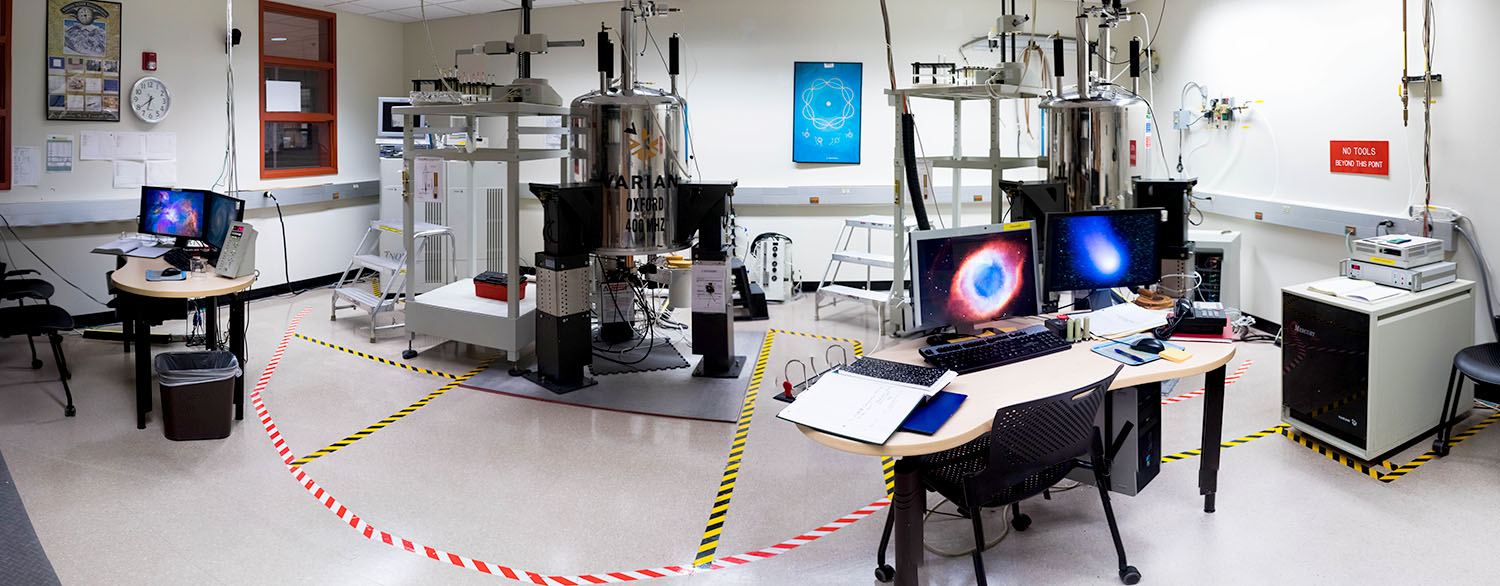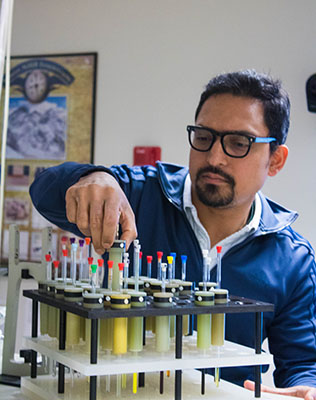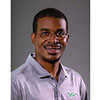About Us
Research Initiatives & Facilities
Initiatives
The Department of Chemistry at USF is an exciting and vibrant community of scholars with the overall goal of creating new knowledge and disseminating that knowledge through both graduate and undergraduate education. Our Department's research focus areas are helping to tackle society's long-term needs for energy and environmental sustainability and improved human health.
CENTER FOR THE IMPROVEMENT OF TEACHING AND RESEARCH IN STEM EDUCATION (CITRUS)
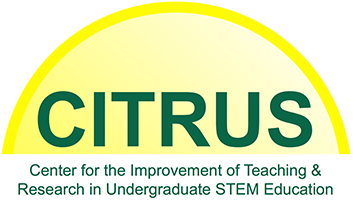
Mission
The CITRUS Mission is to promote postsecondary student success in STEM education through high-impact scholarship and the development of competitive graduate students and postdoctoral scholars highly skilled in research and practice.
Vision
Effective postsecondary STEM education through interdisciplinary learner-centered experiences
Goals
- To generate, translate, and disseminate knowledge on undergraduate STEM education
- To promote collaborative interdisciplinary educational research
- To explore synergies among foundational STEM courses through collaborative engagement with STEM faculty
- To prepare STEM graduate students and postdoctoral researchers with an interdisciplinary perspective on education research
- To prepare STEM graduate students and postdoctoral researchers to utilize evidence-based instructional practices to promote student success
- To facilitate communication among USF stakeholders involved in STEM education
CITRUS Website
Member Faculty
Jeffrey Raker, Chemistry (CITRUS Director)
Milé Krajčevski, Mathematics & Statistics
Scott Lewis, Chemistry
Luanna Prevost, Integrative Biology
Catherine Bénéteau, Department of Mathematics and Statistics
FLORIDA CENTER OF EXCELLENCE FOR DRUG DISCOVERY AND INNOVATION (CDDI)
Overview
USF's Florida Center of Excellence for Drug Discovery and Innovation, CDDI, provides researchers access to specialized equipment not available in most research laboratories that is important for validating protein drug targets and the development of small molecule inhibitors. The CDDI instrumentation cores offer a wide choice of analytical methods with application to the general analysis of proteins and cells. Core facilities include high field NMR, proteomics, protein expression/purification, cell biology, natural products drug discovery/compound analysis and screening.
Laboratory facilities on the third floor of the IDRB offer:
- High field NMR
- Proteomics
- Cell biology
- Natural product-derived drug discovery/compound analysis and screening
CENTER FOR MOLECULAR DIVERSITY IN DRUG DESIGN, DISCOVERY AND DELIVERY (CMD5)
Overview
The University of South Florida (USF) has established the Center for Molecular Diversity in Drug Design, Discovery and Development (CMD5) that takes advantage of existing strengths and cross disciplinary resources in the College of Arts and Sciences, the College of Medicine, the College of Pharmacy, the H. Lee Moffitt Cancer Center and Research Institute, and the Byrd Alzheimer's Institute. CMD5 fosters active collaboration among scientists from these institutions in several disciplines which rely upon advances in molecular science to understand the causes of human disease, develop novel methods for its prevention, and devise novel therapies and treatments.
Thus Mission of CMD5 is "The discovery, design, synthesis and development of new drug lead compounds and drug delivery modes for the prevention and cure of human diseases."
CMD5 Areas of Investigation:
- Drug synthesis and delivery
- Alzheimers/Parkinsons drugs
- Synthetic methodologies
- Bioanalytical methods
- Nanoparticle antibiotics
- Protein synthesis
- Bioassay development
- Antibiotics and anticancer agents
- Natural products
- Nutraceutical R&D
- Biopolymer design and synthesis
- Computer-aided drug design
- Bio-NMR and mass spectrometry
- High-throughput biotesting
CENTER FOR SMART METAL-ORGANIC MATERIALS ADVANCE RESEARCH AND TECHNOLOGY TRANSFER (SMMARTT)
Overview
USF-SMMARTT (Smart Metal-organic Materials Advanced Research and Technology Transfer) is an interdisciplinary research center that was initiated at USF in 2008 with the following mission:
"To discover and develop new 'smart' metal-organic material (MOM) platforms for energy sustainability and enhancement of human health"
The center for Smart Metal-Organic Materials Advanced Research and Technology Transfer originated in 2011, with collaborations between the Chemistry, Engineering and Mathematic Departments at the University of South Florida as a growing need emerged to develop designable porous materials for real-world applications. The current embodiment has grown with more members and teamed up with the Department of Physics at USF. The director of the center (TBD) is one of thirteen professors actively engaged with their postdoctoral, graduate and undergraduate students working on collaborative projects with a central theme to use porous materials, such as metal-organic frameworks, covalent organic frameworks, and porous organic polymers, for each professor's research specialty.
Core Facilities
Our Department manages several state-of-the-art core facilities. The large array of synthetic, characterization, and analysis tools enhances and enables the research programs of Chemistry, the University, and local industry.
USF INTERDISCIPLINARY NMR FACILITY
CHEMICAL PURIFICATION, ANALYSIS, AND SCREENING CORE FACILITY (CPAS)
Contact
Laurent Calcul, Ph.D. (Director)
Phone: NES 406/IDRB 318: (813) 974-6031
Fax: (813) 974-3203
Need a Reservation?
Please Check the Instrument availability below:
- at CPAS NES 406
- at CPAS IDRB 318
- for the MALDI TOF/TOF at IDRB 318
- for the MST at IDRB 318
Overview
CPAS offers its expertise in chromatographic separation and purification (MPLC, HPLC, UHPLC), mass spectrometry detection, identification and quantification (LC-MS SQ, LC-MS QqQ, LC-MS TOF, LC-MS QToF, TDU-GC-MSD, GC-MSD-uECD and GC-MS QTOF [HS-SPME] and MALDI TOF). The services also include Circular Dichroism (CD, VCD), Optical Rotatory Dispersion (ORD), general spectroscopic characterization (UV, FTIR), lyophilization (benchtop and general purpose freeze-dryer), extraction (Accelerated Solvent Extactor [ASE], microwave reactor), synthesis (microwave reactor, hydrogenation apparatus), ADME screening (Parallel Artificial Membrane Permeability [PAMPA - GIT, BBB and skin] and drug solubility evaluation), binding affinity measurement (Microscale Thermophoresis [MST]), and high-throughput screening development capability (liquid handling robot and multimode plate reader). CPAS provides trainings and instruments are available 24/7 in self-service mode and upon reservation for trained users.
- Contact & Billing
- Usage Fees
- Information Poster
- Mass Spectrometry Analysis Form
- Acknowledgement Co-Authorship
USF CPAS EQUIPMENT AND SERVICES (NES 406 and IDRB 318)
CPAS, NES 406
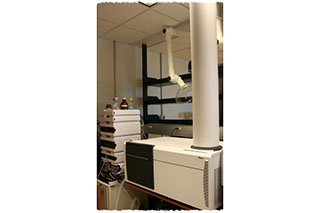
Agilent LC-MS QTOF 6540
-
-
- Ionization: - Agilent Jet-stream Electrospray Ionization (ESI ± ve) and thermal gradient
- Mass Range/Resolution: - Range 40k m/z; Accuracy 20 – 10,000)
- Spectrum Dynamic range: - 5 order of magnitude
- Scan Speed: - 50 Spectra/sec
- Inlet system: - Agilent 1260 HPLC
- Analytes: - Organic, Peptides, Proteins, Natural products, metabolomics and metabolomic identification
- Software: - Mass Hunter Workstation, Mass Profiler Professional (MPP)
- Studies: - accurate mass analysis for HRMS/MS
-
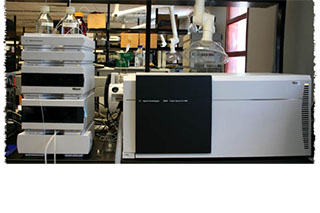
Agilent LC-MS QqQ 6460
-
-
- Ionization: - Agilent Jet-stream Electrospray Ionization (ESI ± ve) and thermal gradient
- Sensitivity: - High sensitivity (Femtomole to Attomole range)
- Inlet system: - Agilent 1260 HPLC
- Analytes: - Organic, Peptides, Proteins, Natural products, metabolomics and metabolite identification
- Software: - Mass Hunter workstation
- Studies: - Tandem mass spectrometry (SRM, MRM) for quantification analysis
-
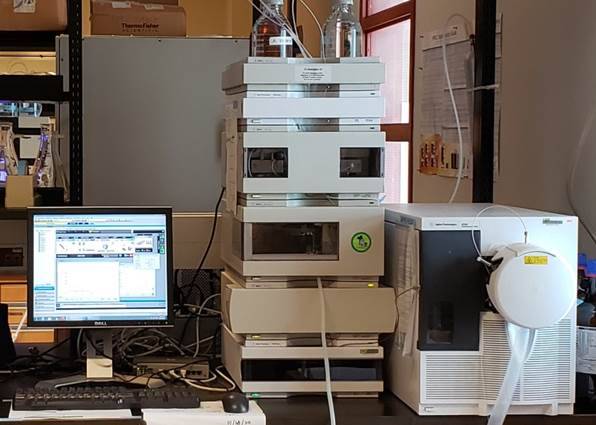
Agilent LC-MS SQ 6120
-
-
- Ionization: - Electrospray (ESI ± ve); Atmospheric pressure chemical ionization (APCI ± ve)
- Mass range: - 10 – 2000 m/z
- Inlet system: - Agilent 1100 HPLC with Diode Array Detector (DAD)
- Analytes: - Organic, peptides, Natural products and non-polar compounds
-
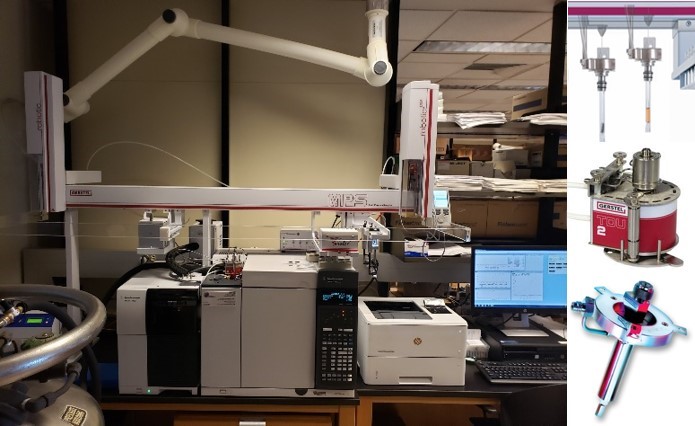
Agilent GC-MSD 5977B
-
-
- Ionization: - Electron impact (EI); Chemical ionization (NCI/ PCI)
- Mass range: - 1.6 – 1050 m/z
- NIST library 2017
- Inlet system: - Agilent 7890B GC
- Analytes: - low molecular weight range, semi-volatile, low-bowling point, non-polar molecules
- Gerstel MultiPurpose Sampler (MPS):
- Dual headed for sample preparation
- 10uL syringe, HS/ 2.5mL syringe and HS SPME fiber
- Cooled Injection System (CIS) allowing cryo-focusing (LN2)
- Thermal Desorption (TDU) and Thermal Extraction using Automated
- Liner Exchance (ALEX) for:Twister/ Stir Bar Sorptive Extraction SBSE
- Thin Film (TF-SPME)
- Desorption liner (absorbent for air sampling)
-
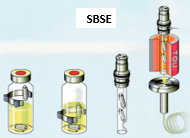
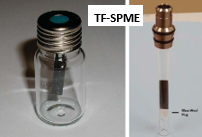
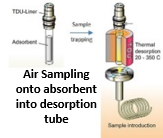
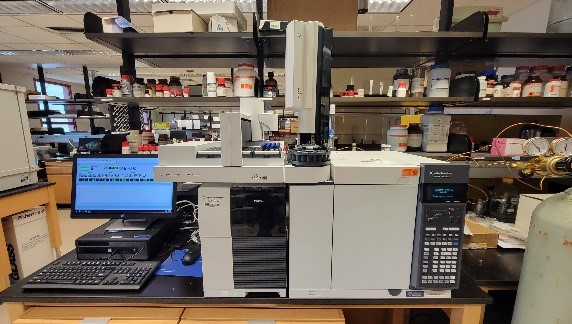
Agilent GC-MSD 5977B/ uECD
-
-
- Ionization: - Electron impact (EI); Chemical ionization (NCI/ PCI)
- Mass range: - 1.6 – 1050 m/z
- NIST library 2017
- 150-sample tray for liquid injection
- 2-inlet system: - Agilent 7890B GC
- Multi-mode inlet (MMI) allowing cryo-focusing (LCO2) connected to MSD
- Split-splitless inlet (SSI) connected to Electron captor detector (ECD) for manual injection
- Analytes: - low molecular weight range, semi-volatile, low-bowling point, non-polar molecules, halogenated compounds
-
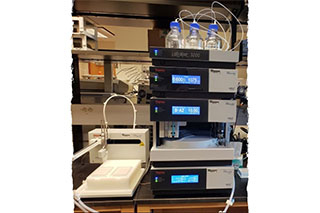
Dionex ultimate 3000 UHPLC DAD
-
-
- Detection: - Ultimate 3000 Diode array detector (DAD)
- UV range: - 190- 800 nm
- Inlet system: - Thermo Scientific Dionex Ultimate 3000 UHPLC+ focused with automated fraction collector (AFC)
- Analytes: - wide range of chemical analytes, from small molecules to biomolecules
-
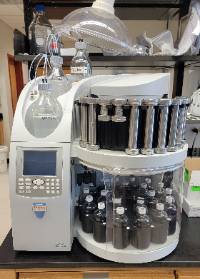
Dionex Accelerated Solvent Extractor (ASE 350)
-
-
- Fast extraction from solid and semisolid matrices
- Reduce solvent consumption
- Pressure up to 1500 PSI
- Temperature up to 200oC
- Nitrogen purge
- Up to 24 samples
- Sample cell volume available (22, 100 mL)
- Environmental, natural products chemistry samples
-

JASCO Model J-1500 Circular Dichroism Optical Rotatory Dispersion (CD/ ORD) spectrometer
-
-
- Electronic CD (ECD)/ORD using UV-Vis spectroscopy
- Simultaneous Multi-Probe: CD, LD, HT, DC, absorbance
- Walength range 163 to 950 nm
- Light Source: Xenon lamp
- Cuvette: 10 and 1 mm pathlength
- Peltier thermostatted 6-position automatic cell changer
- Microsampling (2 mL, 10 mL samples)
- Capillaries (5 mL samples) for cell in thermostatted Peltier
- Diffuse-reflectance CD (DRCD) for solid state sample measurements
- Determine the absolute configuration of chiral molecules, secondary structure, folding and binding properties of proteins
-
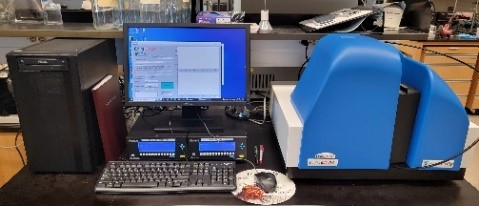
Biotools ChiralIR-2X™ Vibrational Circular Dichroism (VCD) spectrometer
-
-
- Simultaneous IR and VCD signal measurements
- Internal Dual PEM (Photoelastic Modulators)
- Biocell (solution)
- SyncRoCell (rotating cell ideal for solid state measurements)
- TempCon-2X (Peltier temperature controller for cell)
- Determine the chiral properties of small organic molecules, peptide, proteins
-
CPAS, IDRB 318
- Agilent 7890A GC-MS QToF 7200
- Agilent 1200 LC-MS TOF 6230
- Agilent 1260 Preparative HPLC-DAD-MS SQ 6120
- Teledyne-Isco MPLC (UV) and Shimadzu HPLC (UV, ELSD, RID)
- Pion Inc. Parallel Artificial Membrane Permeability Assay (GIT, BBB, Skin PAMPA)
- Pion Inc. Solubility evaluation
- TECAN Infinite M 1000 Pro microtiter plate reader and Freedom EVO 150 liquid handler
- Anton Paar Monowave Reactor 300
- Agilent Cary 60 UV-Vis Spectrophotometer and FTIR 630 Spectrometer
- Labconco Freezone, SP Scientific General Purpose Freeze Dryer (GPFD), rotary evaporators and other concentrators
- Innovatice Technologies Pure Solv Micro solvent purification system for anhydrous solvent preparation
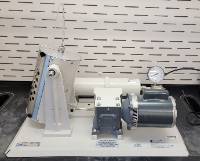
Paar shaker hydrogenation apparatus model 3921
-
-
- Explosion Proof Motor and Switch
- 1L shaker bottle
- Treating chemicals with hydrogen in the presence of a catalyst (60 PSI)
- Catalytic hydrogenation, reduction or condensation for organic synthesis
-
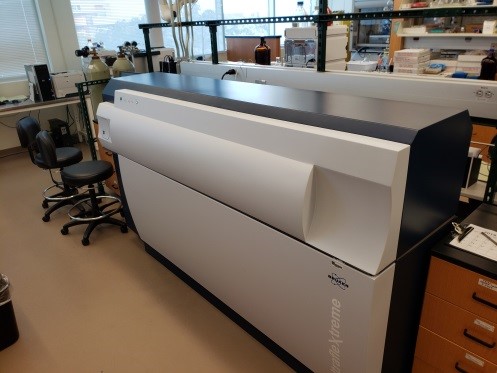
Bruker UltraFleXtreme MALDI- TOF/TOF
-
-
- Smartbeam II, 2 GHz for MS and 1 GHz for MS/MS
- FlashDetector™ with 5 GS/s 10 bit digitizer for enhanced dynamic range
- Resolution > 45,000
- Analytes: - Protein, peptide, lipids, natural products and polymer
- Software: - FlexControl, FlexAnalysis, FlexImaging
- Supporting Software: Biotools, Polytools, SCiLS Lab
-

Nanotemper MicroScale Thermophoresis (MST) Monolith
-
-
- Molecular interaction, binding affinity measurements (Kd)
- Fluorescence channels: RED & BLUE
- Dynamic range 1nM to uM
- Up to 24 samples/ run
- Small molecules, proteins, DNA, …
- JOVE MST link
-
USF X-RAY DIFFRACTION FACILITY AND SOLID STATE CHARACTERIZATION CORE LAB (XRAY)
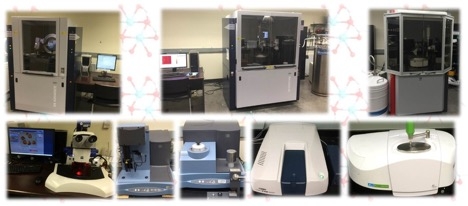
Overview
USF X-ray Diffraction Facility and Solid-State Characterization Core Lab (XRAY) provides access to instrumentation and services needed to characterize crystalline solid state samples. The lab specializes in Crystallography, Single Crystal X-ray Diffraction and Powder X-ray Diffraction. We use X-ray Diffraction methods to solve structures of single crystals and to identify and characterize crystalline powder samples. Core Lab also provides access to TGA, DSC, FT-IR and UV-VIS instruments and is extensively used by synthetic and materials scientists working at University of South Florida as well as at other academic institutions and commercial entities.
Services
- Single Crystal X-ray Diffraction - SCXRD
- Powder X-ray Diffraction - PXRD
- Thermogravimetric Analysis – TGA
- Differential Scanning Calorimetry – DSC
- FT Infrared Spectrometry - FT-IR
- UV-VIS-NIR Spectrophotometry - UV-VIS
The X-Ray Crystallography lab can analyze both: standard and "low" quality single crystals. We can handle microcrystals, disordered and twinned crystals, unstable crystals like solvates, supramolecular crystals, peptides and MOFs. The turn-around time can be as short as 24-hours for good quality samples. The use of Cu radiation allows us for reliable determination of absolute configuration for organic compounds. We can determine unit cell parameters, screen samples, collect variable temperature data and process the data from other instruments / detectors. We provide full publication report for analyzed samples. In case of Powder Diffraction experiments, we can help in phase identification using PDF-2 database, indexing, powder pattern fitting in TOPAS software. We will also tune instrumental setup in order to obtain the best possible Diffraction Pattern for powder sample. All scientists are welcome to use instruments after the training.
For a list of available equipment, click here.
Contact
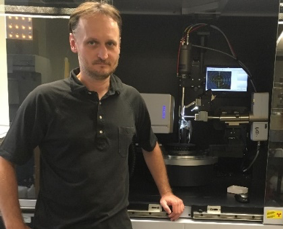
Lukasz Wojtas, Ph.D.
Crystallographer & Director
Research Assistant Professor
USF Department of Chemistry
Phone IDRB: (813) 974-3451
Fax: (813) 974-32
| Office & Lab Address | Shipping Address |
|---|---|
| University of South Florida Department of Chemistry 3720 Spectrum Blvd, 2nd floor, IDRB202H (Office) IDRB 211B (Lab), Tampa, FL 33612 |
University of South Florida Department of Chemistry 4202 E Fowler Ave, NES 107 Tampa, Fl 33620 |
AFFILIATED FACILITIES AND RESOURCES
In combination with Cell Biology, Microbiology and Molecular Biology (CMMB), Physics, Research Computing, and Engineering, the sky is the limit!
